Finalists announced in purmundus challenge 2020; winners to be revealed during Formnext Connect
October 8, 2020
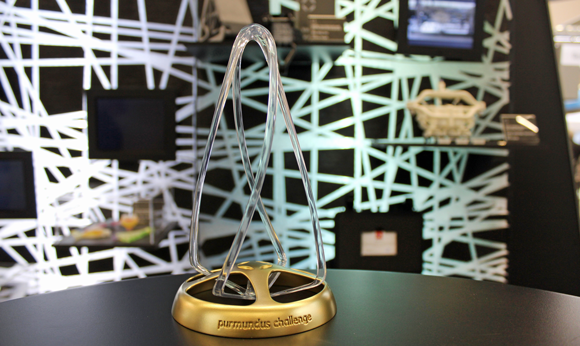
cirp GmbH, organiser of the purmundus challenge, has revealed the thirty-five finalists in this year’s competition. The challenge winners will be announced on November 11, 2020, as part of Formnext Connect, the digital event which replaces Formnext this year due to the coronavirus pandemic (COVID-19).
Commenting on the 2020 challenge, the organisers stated, “This year’s finalists show the enormous potential of Additive Manufacturing. 3D and 4D printing are more than ever and increasingly around the world a core manufacturing process paving the way for smart innovations in various different markets.”
The purmundus challenge finalists comprise product ideas that demonstrate the 2020 challenge theme of ‘Geometry and Material in Harmony’, and come from thirteen countries on five continents,
“The finalists in this year’s purmundus challenge are innovative, forward-looking concepts in the fields of medicine, 4D printing, automation, robotics, kinematics, mobility and aerospace engineering. In addition to a fashion collection, textiles as the frame for an item of clothing, and shoes, the finalists include two sports products,” noted the organisers.
Design products from the film industry and the fields of architecture, interior design, leisure, education, food made from vegetable proteins and a luminescent organism for the living room are also in the running. Further finalists include new materials, potential applications for professionally manufactured AM porosity and other characteristics of digital materials, and new post-processing technology.
The purmundus challenge panel will select the winners by considering the benefits of each product in terms of use, economy and aesthetics, as well as design and innovation. The awards are worth a total of €30,000.
A live-broadcast award ceremony will take place in Frankfurt, Germany, on November 11. In addition to the top three prizes, the purmundus challenge will also feature awards in the categories of Special Mention, Simulation-Driven Design, an Innovation Prize and the first-ever Newcomer Prize.
A People’s Choice Award, the winner of which is determined using the external PollUnit platform, will also be given.
Metal Additive Manufacturing finalists in the Purmundus Challenge 2020
Titanium Skeleton shoe design, by Nadin Ram

The Titanium Skeleton is a high-heeled shoe collection developed by Nadin Ram, in collaboration with the Israeli Institute of Metals, the Technion. The collection uses anatomical and minimal structures, additively manufactured in titanium using Electron Beam Powder Bed Fusion (PBF-EB), and an ‘anatomical foothold’ made of transparent additively manufactured polymer.
The foothold, tailor made for the wearer, is mechanically separated into the titanium structure, which can be replaced and exchanged to offer the wearer a range of different colours, textures or customised designs.
“The ‘skeleton look’ in my heel shoe collection truly accentuates my fantasy of being ‘born in heels’ as they are the integral part of a woman’s body,” explained Ram. “My collection uses anatomical and minimal structures which is printed in titanium for the purpose of ‘lifting’ and holding the foot in a high heel position.”
Robot Arm, by MX3D in collaboration with Altair, ABB et al
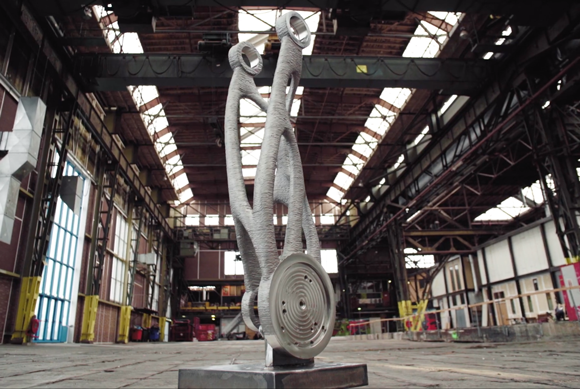
The optimised industrial Robot Arm is the result of a long-term project undertaken by metal AM company MX3D, based in the Netherlands, in collaboration with Altair, ABB, Thomas Van Glabeke, Mirko Bromberger, Jaideep Bangal, Tony Gray, Michael Wawrzinek, Richard van Dam, Cas Nieuwland, Max Peek, Martin van der Have and Gino Seesing.
The Robot Arm was designed by engineers at Altair for a robot supplied by ABB, with the goal of customising and optimising the robot arm for operational requirements and conditions. It was fully additively manufactured in stainless steel using Wire Arc Additive Manufacturing (WAAM), and achieved a weight reduction of over 50% compared to the original part.
The large-scale optimised part was first presented to the public in November 2019, just before installation. After a pause in the project due to the coronavirus pandemic, the installation of the optimised part in the original industrial robot has now been completed successfully by the project team.
The Robot Arm project now covers the complete process, starting from disassembly, reverse engineering, optimising, Additive Manufacturing, finishing and finally assembling and using the robot. This allows for rapid and automated production of large-scale parts that normally require extensive tooling and overseas production, causing long lead times and limited customisation options.
Hope Top Crown Stem Combo 31.8 for Fox 40, by Dunamis Cognitio, Landmark University, Nigeria et al
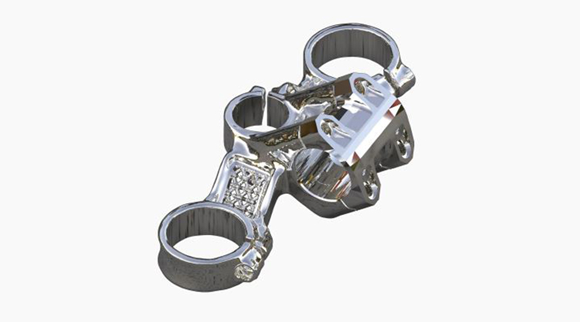
The Hope Top Crown Stern Combo 31.8 for Fox 40 by Hope Technology (IPCO) Ltd is a part for a mountain bike said to offer high performance, strength and stiffness.
Using generative design and Additive Manufacturing, the design team Dunamis Cognitio, Landmark University, Nigeria; Mechanical Engineering, Obasogie Okpamen,
Obasogie Ikponmwosa and Obasogie Osasumwen were able to take advantage of lattice structures and topology optimisation to replace a legacy part.
The crown gives a 50 mm reach whilst keeping the handlebars of the bike as low as possible. The original part was produced by CNC machining from a solid billet of 2014 T6 aluminium. With the AM alternative, the designers were able to achieve equal performance with less material consumption and better aesthetics.
Bolt it, by ETH Zürich, Inspire AG and Gressel
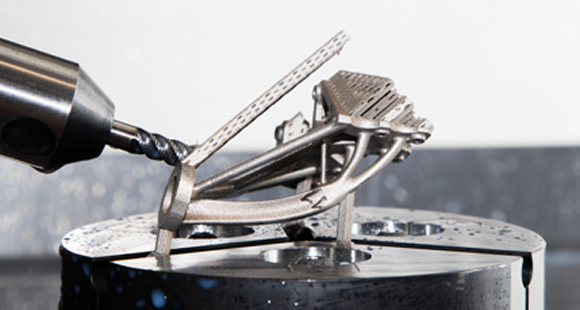
Bolt it was designed through a research and development collaboration by ETH Zürich, Inspire AG and Gressel. The Bolt it concept enables an automated physical and digital post-process chain through automated gripping and handling of the AM part for post-processing.
Using this automated gripping and handling tool, robust machining, with accessibility from five sides, is made possible. A simple torsion removal of the interfaces completes the process.
The two-year project to develop Bolt it was funded by the innosuisse and headed by Julian Ferchow, Research Associate at Inspire AG, ETH Zurich, and Marcel Schlüssel, Head of Technology at Gressel.
Moorhuhn Fahrradrahmen, by HUHN cycles and Ralf Holleis
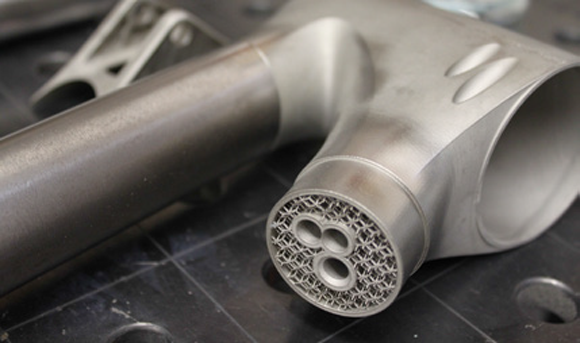
The Moorhuhn, a mountain bike part produced by HUHN cycles and Ralf Holleis, reportedly combines the advantages of super light titanium tubes with additively manufactured lugs. This makes the joints extremely stiff, explain the designers, as they can be designed according to the forces within a bicycle frame in order to distribute them equally.
The Moorhuhn joints are said to be extremely light and stiff, thanks to an internal lattice structure which supports their very thin walls. The use of AM also makes it possible to produce each frame according to the needs of each individual, so that functions like cable guiding, seat clamps, bearing housings and additional material for welding can be integrated into the design.
“The bicycle industry developed very quickly the last couple years, bikes got lighter and stiffer at the same time,” stated the designers. “Those great achievements were mainly possible with a composite material called carbon fibre, but unfortunately producing this material has a very high carbon footprint. In addition, carbon products have a very short product life-cycle as there is a certain safety risk in using second hand or crashed carbon products.”
“Sadly, there are nearly no ways to recycle this composite material, so most of the time carbon frames end up in landfill or get burned,” they noted. “Metal recycles forever!”
nTop Platform – Heat Exchanger Design and Simulation, by nTopology and Maiki Vlahinos
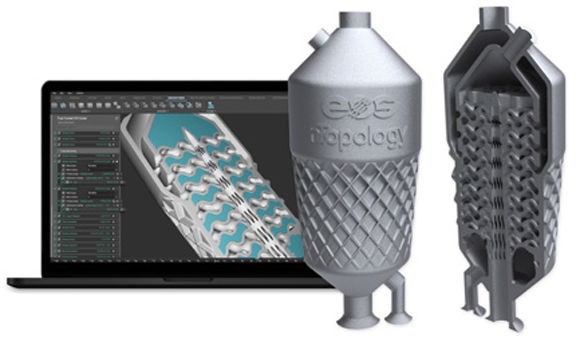
Using nTopology’s advanced geometry kernel in nTop Platform, it is now possible to produce the next-generation of high-performance heat exchangers for the aerospace industry using advanced materials and manufacturing methods. When coupled with ANSYS CFX, the evaluation of these high-performance designs can be achieved in ways that were not previously possible.
This design was inspired by an America Makes project to leverage Additive Manufacturing on a legacy shell and tube HEX for both part replacement and to discover whether advanced design and manufacturing could be used to increase the performance of a legacy component.
In this example, nTop Platform was used to define a volume that could be used to iteratively design a modified FCOC that maximises surface area while minimising mass within its interior walls. With these constraints there are only two ways to increase the performance of a HEX: maximising surface area and minimising wall thickness.
By using nTop Platform to design the internal core with a gyroid structure, it was possible to increase the surface area by 146% and reduce wall thickness by half, which increased the overall heat transfer of the FCOC by approximately 300% within the same volume as the legacy design.
Thermally Optimized Engine, by nTopology and Nicky Soane
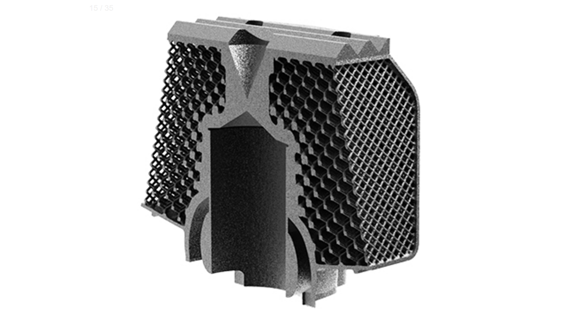
nTopology supported Cobra Aero and Renishaw in a project to optimise the design, development and AM of Cobra’s new A33 drone-engine cylinder. Test results on the additively manufactured, air-cooled component – which has a novel, interior lattice structure designed with nTop Platform software – demonstrated superior performance to Cobra’s current exterior-fin design.
Cobra Aero already had a finned cooling system – an AM-adapted, commercially successful design that is being flown now. However, the existing AM part required a lot of post-processing because it had almost as much support structure on the cooling fins as material in the part itself.
Looking for alternatives to fins, Hilbert’s team turned to internal lattice structures. By hollowing out a solid aircraft bracket and filling the space with a lattice, honeycomb or gyroid structure, weight can be decreased and strength improved. Because lattices are self-supporting, they don’t require any support structures during the AM build.
Arch, by Maximilian Klyk
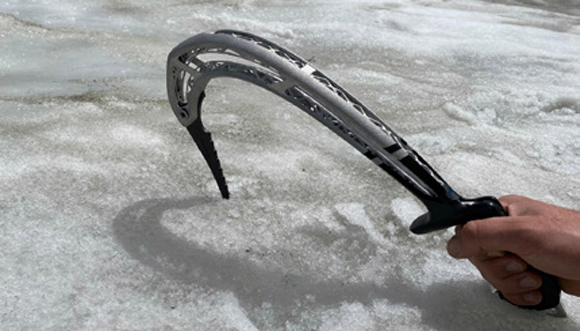
Arch is a technical ice-climbing device produced in ALSi10Mg using Laser Beam Powder Bed Fusion (PBF-LB) by Maximilian Klyk as part of his diploma in Industrial Design at Darmstadt University of Applied Sciences. The use of AM made it possible to revolutionise the product with innovations relating to use, experience and appearance.
Ice climbing tools must be light enough to enable climbers to conserve strength and energy while climbing, but heavy enough to carry the momentum required to penetrate the ice. The use of AM made it possible for Klyk to reduce the overall part weight while also integrating an ‘acceleration system’, resulting in an impact energy equivalent with heavy equipment produced by conventional methods.
The acceleration system consists of a ball that runs along a track integrated in the lightweight structure of the device. When the user swings the tool, centrifugal force pushes the ball towards the head, where the impact transfers momentum and energy into the pick.
Hot versus cool: highly efficient heat transfer through capillary effects with ‘Digital Materials’, by Siemens AG, Corporate Technology
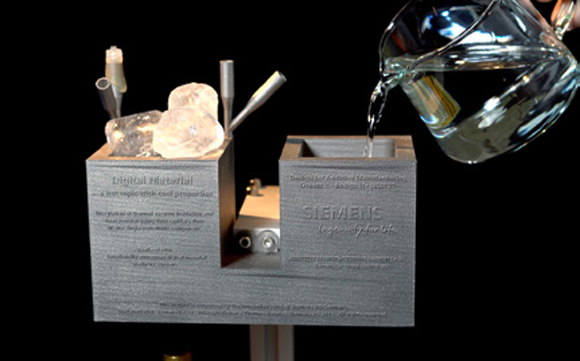
This heat transfer system, produced by PBF-LB, was developed by Siemens AG, Corporate Technology; Dr Christoph Kiener; Dr Yves Küsters; Robert Otto and Thomas Braun. The part comprises a heat pipe, an evaporation-condensation heat transfer system (pressure cooker principle) and vacuum insulation.
When operational, ice placed directly above the gas flame does not melt, but water boils at some distance from the flame without any visible heat source. The capillary transport of fluids takes place hidden from view inside the heat pipe; heat is transported by the evaporation and condensation of this fluid. This is said to be a very attractive application for the transporting of large amounts of heat across long distances in confined spaces with small cross-sections.
The heat pipe works ‘passively’, without any mechanical or electrical components, relying purely on the capillary effect.
3D printed piston 911 GT2 RS, by Porsche AG, Mahle International GmbH, Trumpf GmbH & Co. KG et al
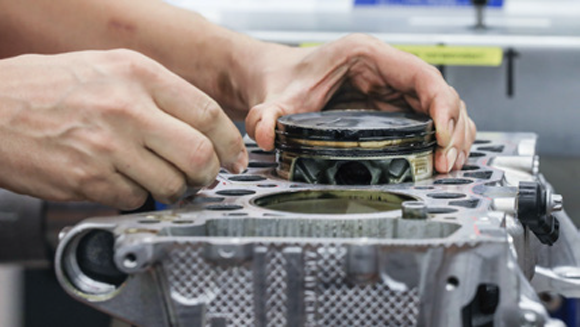
This piston for a Porsche 911 GT2 RS was developed by Porsche AG; Mahle International GmbH; Trumpf GmbH & Co. KG; Frank Ickinger; Volker Schall; Dominik Abele and Steffen Rübling. It is metal additively manufactured using PBF-LB and an Mahle aluminium alloy material designed specifically for use in pistons.
The objectives of the piston’s design were to increase the part’s rigidity and reduce its weight through topology optimisation; integrate cooling channels into the part; reduce development time from prototype to series production part; and eliminate tooling costs.
Testing of the final part showed improved performance and efficiency over 200 hours of endurance testing, twenty-four hours on a high-speed testing track, 135 hours at full throttle at different rpm values, and twenty-five hours towing a load at different rpm values.
















